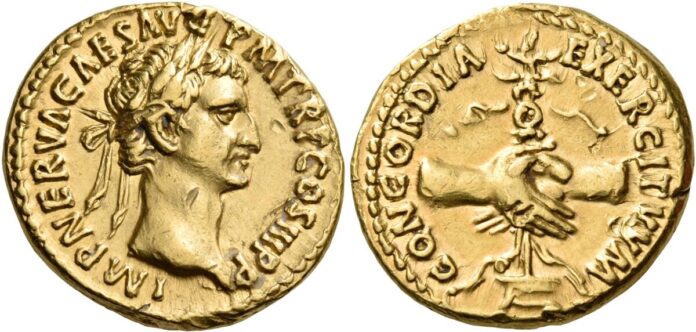Alan Walker Presents Highlights from Nomos 20
Yes, Nomos 20 has been rescheduled, and will be taking place on 10 July in the Zunfthaus zur Saffran in Zürich, starting at 16:00 CEST! It will definitely be worth waiting for – as usual; there are 476 lots of coins, ranging from the ancient Celtic, Greek and Roman, through Byzantine and Medieval, and up to a surprisingly pretty group, of mostly gold pieces from Renaissance and early Modern Salzburg, Nuremberg and Regensburg.
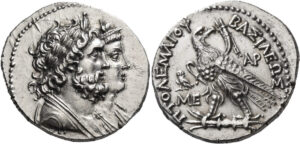
This is an apparently unpublished tetradrachm of Ptolemy V, minted in the Cilician city of Soli (lot 290, estimate 2750 CHF). The obverse shows the jugate heads of Serapis and Isis, both draped and wearing elaborate ornaments on their heads. The reverse bears the usual Ptolemaic eagle, albeit one that turns his head back to right, magistrates’ initials and, both surprisingly and endearingly, the owl of Soli. The fact that this coin was minted in Soli, far away from Egypt itself, should be a reminder that the Ptolemaic kingdom did not solely include what is now modern Egypt, but it also included much of the Levantine coast, as well as Cyprus, parts of Asia Minor, the Greek Islands and strongholds on the Greek mainland.
Just because a coin comes from a group that is, in general, relatively common, it does not mean that it can’t be both remarkably attractive and very desirable, indeed. For example, if you were searching for a really dramatic and powerful portrait of Augustus, could you easily find a better one than this?
Then we have lot 300 (est. 450 CHF), a silver tetradrachm minted in Antioch in AD 6. It bears a simple, laureate head of the Emperor accompanied by his name, written in large, even Greek letters – perhaps lacking the outstanding lapidary excellence of the best Latin inscriptions that appeared on contemporary coins minted in Rome or Lugdunum, its boldness nevertheless perfectly compliments the portrait. Of course, this head is somewhat idealised, showing us an Augustus who was a handsome, noble ruler – un parfait prince – of true, Julio-Claudian excellence. But the Antiochene engravers, when they wanted to, were also perfectly capable of presenting us with a tough, craggy Roman, with a warts-and-all sternness harking back to the Republic:
Minted 62 years later than the tetradrachm of Augustus, a large bronze (a sestertius? – lot 308, est. 450 CHF) bears a portrait of Galba derived from a particularly realistic and tough Roman model, designed to emphasise the ancient Roman values that Galba embodied, but that were so flagrantly flouted by Nero!
It should not be forgotten that many of the coins on the market today come from collections of the past, and have histories that can go back centuries, if only we knew them! When we read in an auction catalogue or a list, that a coin comes out of an old collection this is not merely verbiage put in to help sell the coin, but it often actually describes from where it comes: a collection formed a long time ago, but with its true origins lost in time. Here, however, we have a coin that has a collection history that can be confidently traced back to at least the 1840s and, in addition, for about 100 years was in one of the greatest coin collections in the world:
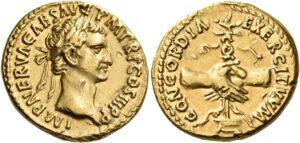
This is lot 317 (est. 10,000 CHF), an aureus of Nerva, which not only was once in the collection of the British Museum (!) but was also in the collection of Louis Charles, the second Duc de Blacas d’Aulps (1815-1866 – if it had not already entered that of the first, Pierre-Louis, 1771-1839). Luckily for us this coin was illustrated in the third volume of BMCRE (pl. 1, 15); it was deaccessioned as a duplicate at some point prior to being by sold by Spink’s in 1966. It should not be forgotten that museum authorities long believed that there was no sense in keeping multiple examples of the same coin, or coin type, other than if they were pieces deriving from archaeological excavations or known hoards (even then they did not keep innumerable duplicates). The reason why this coin was sold or traded by the BM was a good one: they had another and they could use the funds received to augment the museum’s holdings of other types, then missing. In other cases, however, coins once in the collections in non-numismatic museums have been disposed of by proudly arrogant and snotty directors who valued all manner of other objects more highly than they did coins: like Thomas Hoving of the Metropolitan Museum of Art in New York and Froehlich Rainey at the University Museum in Philadelphia. In addition, coin collections once in the possession of universities and schools have long been sold off to fund all sorts of improvements, often with the excuse of there being no safe way to keep them (like the Garrett coins from Johns Hopkins, the King Collection at Bryn Mawr, the collections of the Westminster School and Eton, etc.). In any event, knowing that the present coin was once an esteemed part of two truly famous and select collections should make its new owner particularly proud!
Beginning with the overthrow and murder of Severus Alexander by Maximinus in 236, but definitely following the assassination of Gordian III in 244, Rome entered into what became known as the Age of the Soldier Emperors, a period of interminable military strife that began to come to an end with the accession of Diocletian in 284, but only truly ceased after Constantine I’s defeat of Licinius in 324, when dynastic succession came to the fore. A really good history of this period, albeit now out of print, is G. C. Brauer’s The Age of the Soldier Emperors. Imperial Rome A.D. 244-284 (Noyes Press, Park Ridge, NJ, 1975). The coinage mirrored these changes, providing us with imperial portraits that portrayed the emperors as tough, military men rather than civil leaders who were ostensibly the supreme commander. Here are two examples:
Lot 357 (est. 300 CHF), a remarkably nice tetradrachm of Philip I, struck in Antioch in 244, shortly after he came to the throne. Here we have an outstandingly fine portrait of the soldier-emperor, which shows him in a somewhat refined and elegant way; this is a thoughtful soldier. The quality of the engraving is simply outstanding: while from a provincial mint, it is anything but provincial.
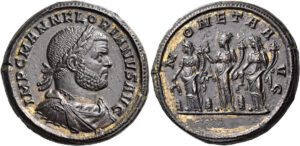
But some 32 years later we have someone entirely different: the emperor Tacitus’s brutally tough half-brother Florian, who ruled for a few months in 276 and is shown on a very rare medallion struck in Rome soon after his accession (lot 375, est. 95,000 CHF). Yes, this is an elegant portrait – and of course the coin itself is in superb condition – but it also shows us a man of unbending sternness, who was concerned to show a face to the world redolent of power. However, as we know, Probus, the Roman commander in Syria, was even tougher and more competent, so when he was also proclaimed emperor he soon prevailed and Florian was murdered.
We rarely have cataloguing errors here at Nomos, but we often can have uncaught typos and things like that. However, one error in Nomos 20, caught by a sharp-eyed and expert collector, is weirdly inexplicable; so much so that the only possibility is some form of demonic possession taking over the computer and putting it there!
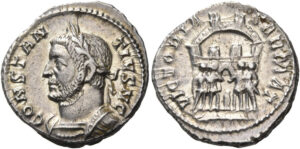
This is lot 382 (est. 2250 CHF), a very, very rare argenteus of Constantius II, which is neither in Jelocnik nor RIC VI, but is otherwise known from a correctly catalogued piece that appeared in a CNG esale in 2013. In our catalogue it is inexplicably ascribed to the mint of Lugdunum, rather than Treveri – Trier – as was correctly noted back in 2013 (it comes from the issue with the club/staff mint mark and either a draped or cuirassed bust, as RIC VI, p. 177, 119-120). We would very much like to thank that client of ours who pointed this strange error out to us!
This is enough for today! You can find the entire sale on our web site, on Sixbid, on biddr and on NumisBids; do look at all the lots because they are all interesting and attractive!
Remember, if you have any questions or numismatic problems, or have coins you want to buy or to sell, let us know.
Please also note that from now on there will be no additional fee charged for internet bidding. internet bidders pay the standard buyer’s fee of 22.5%, as is charged to postal and email bidders.



